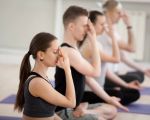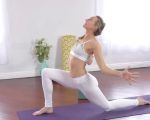- 1-creating-the-right-environment-for-home-yoga
- 2-establishing-a-consistent-yoga-routine
- 3-choosing-the-right-yoga-style-and-resources
- 4-setting-realistic-goals-and-tracking-progress
- 5-incorporating-mindfulness-and-breathing-practices
- 6-overcoming-common-challenges-in-home-yoga
- 7-finding-support-and-inspiration-from-free-yoga-links
Creating the Right Environment for Home Yoga
Building a successful home yoga practice begins with designing a dedicated space that promotes calm and focus. This doesn’t require a large area—just a quiet corner with enough room for your mat and minimal distractions.
Consider elements like natural light, comfortable temperature, and calming decor to enhance your practice experience. A peaceful environment helps deepen concentration and fosters a consistent routine.
Establishing a Consistent Yoga Routine
Consistency is key when developing a home yoga practice. Setting a regular schedule—whether daily or several times a week—builds habit and momentum. Start with manageable session lengths, such as 15-30 minutes, and gradually increase as your comfort and interest grow.
Using reminders and journaling your progress can keep you motivated and accountable, transforming yoga into a rewarding lifestyle element.
Choosing the Right Yoga Style and Resources
Selecting a yoga style that aligns with your goals and preferences is important. Beginners may prefer gentle Hatha or restorative yoga, while others might be drawn to more dynamic Vinyasa or Power Yoga.
Access to quality resources enhances your home practice. Online videos, apps, and guided classes offer flexibility and instruction tailored to all levels. Exploring various teachers and formats helps you find what resonates best.
Setting Realistic Goals and Tracking Progress
Define clear and achievable goals to give your practice direction, such as improving flexibility, reducing stress, or enhancing strength. Tracking milestones—like mastering poses or increasing session time—builds confidence and a sense of accomplishment.
Remember, yoga is a personal journey, and progress can be non-linear. Patience and self-compassion are essential companions.
Incorporating Mindfulness and Breathing Practices
Beyond physical postures, integrating mindfulness and pranayama (breath control) enriches your home yoga routine. These practices cultivate awareness, reduce anxiety, and deepen relaxation, providing holistic benefits that extend off the mat.
Starting or ending sessions with focused breathing exercises can ground your mind and enhance the overall yoga experience.
Overcoming Common Challenges in Home Yoga
Practicing yoga at home comes with challenges like distractions, lack of motivation, or uncertainty about technique. To overcome these, create clear boundaries for your practice time, set realistic expectations, and seek virtual communities for support.
Adjusting your environment and goals as needed keeps the practice enjoyable and sustainable.
Finding Support and Inspiration from Free Yoga Links
For abundant resources and community support, explore Free Yoga Links. Their curated collection of classes, tutorials, and articles provides inspiration and practical guidance for all levels.
Leveraging these tools helps you build a well-rounded and fulfilling home yoga practice tailored to your unique needs.








